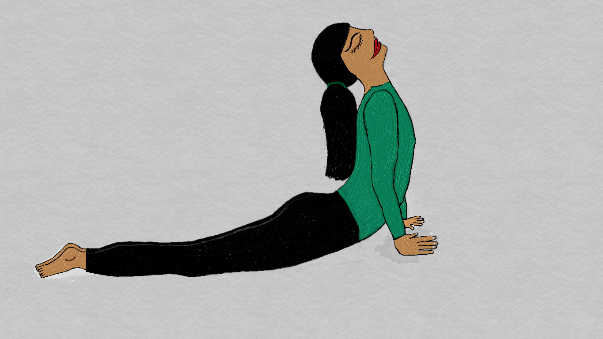|
Aah! And the year 2016 draws to an end as I write this last post for the year.
The seventh posture in the Suryanamaskar is the cobra pose or the bhujangasana. • Posture: From the eight-point salutation pose, extend the feet by pointing toes and resting the dorsum (top of foot) of the feet on the floor. Next lower the thighs onto the floor by bringing the hips to neutral from flexed position. The legs are resting on the floor from shin to thigh as you begin lifting the torso while extending the lumbar spine as you push the chest out. The spine should simultaneously stay elongated as you achieve a uniform curve, moving up towards mid and upper back. The palms facing down, resting on the floor are just behind the shoulders in the beginning and end up in front of shoulders as end posture is reached. The elbows may be in any degree of flexion to complete trunk extension, based on available range of spinal extension and trunk lift from the floor. Finally, you can push the palms into the mat as you open up the chest by rolling shoulder blades down and in. • Muscles: The plantarflexors in your legs (gastric-soleus and their synergists) facilitate pointing the toes or plantarflexion of the feet. An eccentric lengthening of the hip flexors with hip extensor contraction (gluteus maximus, biceps femoris and semitendinosus) ensures smooth lowering to the floor. It is important to pull in the navel to initiate the spinal movement with the transverse abdominals, obliques, and multifidi which stabilize the spine and then engage the erector spinae, latissimus dorsi and quadratus lumborum for lumbar and thoracic extension(stability before movement protects the spine). Sometimes if spine is stiff/weak it is not possible to arch the low back and in that case, one may use the arms to push-up and extend trunk. The rhomboids and middle trapezius bring the shoulder blades towards midline and maintain stability. The anterior chain muscles like the iliopsoas, rectus abdominus, pectorals and anterior deltoids are stretched with opening of the shoulders. Triceps facilitate weight transfer from upper arms via the extended wrists and flat palms on the floor). • Breathing: This is a classic backward bending posture and hence is accompanied with a deep breath in and hold at end of pose. This posture opens up the upper lobes of the lungs and one can notice the air rushing in to open the air sacs in the upper chest area. Inhale deep by availing the accessory muscles of breathing (in the neck), as they further elevate the upper ribs. “Om Hranyagarbhaya Namaha" I bow to thee, one who contains everything.
0 Comments
Your comment will be posted after it is approved.
Leave a Reply. |
Details
AuthorAmi Gandhi is a licensed physical therapist in the state of California. She is the owner of StableMovement Physical Therapy, a small boutique practice in San Jose that offers patient centered, one-on-one, hands-on physical therapy. Archives
March 2018
Categories |
